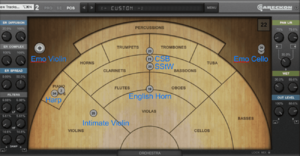Land of Missing Parts
Grumpy Monkey
Here is my mockup of the first movement of Nocturnes, composed by Claude Debussy.
Amidst heated discussion about Spitfire Studio Woodwinds, I decided to pick up the core version, and run it through its paces, along with Emotional Violin, which I picked up recently on sale. (The english horn, please note, is from Berlin Woodwinds Legacy since SStW doesn't include one. And it happens to be the most prominently featured woodwind in the piece.)
In my opinion, SStW did a decent job, though there were a few times that I wished I could have gotten a more expressive line out of them, and they are a bit on the thin side. But overall, things just worked as they should and I think it is very capable library at a reasonable price.
Emotional Violin is an instrument I need to spend more time with, but I think it did a decent job as well. There are some bowing transitions I wish could have been smoother, but overall I'm loving this instrument.
Cinematic Studio Strings does a lot of the heavy lifting. Here, it helped with the expressiveness. But I'd also point out that I had a lot of trouble getting the quiet repetitive ostinatos around 1:28 and 3:02, as there's a weird mechanical pumping feeling to it that I just couldn't program around. I'd be interested in people's suggestions on how to handle a part like that.
As always, I'm all ears for comments and criticisms. Thanks for listening.
The next movement of Nocturnes is in the works.
Libraries used:
Cinematic Studio Strings & Brass
Spitfire Studio Woodwinds Core
Berlin Woodwinds Legacy (english horn)
Emotional Violin & Cello
Chocolate Audio Glissando Harp
Rhapsody Orchestral Percussion
Amidst heated discussion about Spitfire Studio Woodwinds, I decided to pick up the core version, and run it through its paces, along with Emotional Violin, which I picked up recently on sale. (The english horn, please note, is from Berlin Woodwinds Legacy since SStW doesn't include one. And it happens to be the most prominently featured woodwind in the piece.)
In my opinion, SStW did a decent job, though there were a few times that I wished I could have gotten a more expressive line out of them, and they are a bit on the thin side. But overall, things just worked as they should and I think it is very capable library at a reasonable price.
Emotional Violin is an instrument I need to spend more time with, but I think it did a decent job as well. There are some bowing transitions I wish could have been smoother, but overall I'm loving this instrument.
Cinematic Studio Strings does a lot of the heavy lifting. Here, it helped with the expressiveness. But I'd also point out that I had a lot of trouble getting the quiet repetitive ostinatos around 1:28 and 3:02, as there's a weird mechanical pumping feeling to it that I just couldn't program around. I'd be interested in people's suggestions on how to handle a part like that.
As always, I'm all ears for comments and criticisms. Thanks for listening.
The next movement of Nocturnes is in the works.
Libraries used:
Cinematic Studio Strings & Brass
Spitfire Studio Woodwinds Core
Berlin Woodwinds Legacy (english horn)
Emotional Violin & Cello
Chocolate Audio Glissando Harp
Rhapsody Orchestral Percussion
Last edited:






